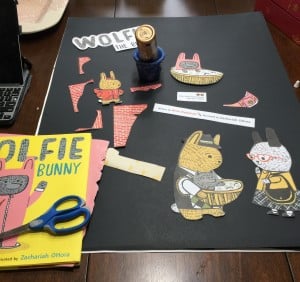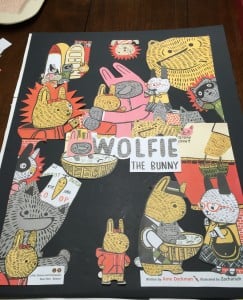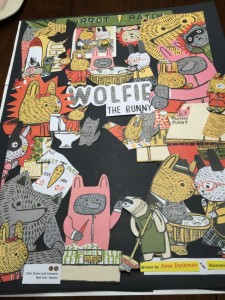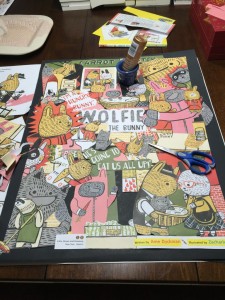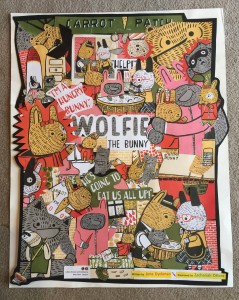It begins here. It always begins here. A few images clipped from the book knowing that I have left many more within the book that will need to be removed later for the finished remix. Images clipped from a book. It sounds a lot like symbol, doesn’t it?
But, Ame’s text and O’hara’s illustrations gives all kinds of visual text. There are spilled honey bottles to contend with. There are vegetables from Carrot Patch, the corner store. There are action and emotion lines that communicate movement, anxiety, peril. . .being squashed by a would-be attacking bear. There are scales and registers and shopping bags and toilets. There’s a sloth shop keeper. So many images.
While cutting Wolfie the Bunny apart, I kept coming back to the idea of “anticipatory set.” Looking at the remix before there is a remix is much like our younger readers looking at the cover of a book and asking to themselves, “What could this be about?”
Wolfie the Bunny is playful comic caper. The case of the book begins to suggest this with the back cover art in reverse of the front. The author and the illustrator want you to have fun with this book. Wolfie the Bunny is part Duran Duran’s “Hungry Like the Wolf,” part Telemundo drama with all of the dramatic pauses and close-ups and part Tex Avery lets loose on the adoption of another species gag.
While there are many small comic details coming out of Wolfie the Bunny, there are also really large images to contend with as a remix artist. The trim size of the book allows for some full page images to appear as well as spread-layered images that give the one holding the scissors a lot to think about.
The same is true of our younger readers by way of reflection upon reading. What are the big pieces? How do they move separately to carry the story? How do they move together? When are they coupled firmly and when can they be moved about to amplify their importance to the overall message and theme of the book? These are questions I ask myself even while I am cutting the images from the book (the easiest part of the process, by the way). Cutting images and following the lines given to me by the artist give me lots of incubation time to think about the final remix of the piece. Our brains are phenomenal this way and there is a lot to be said for the Kinesthetic act of cutting and placing that are the major components of the “drafting” phase of a remix.
Notice how the separate images are starting to move within the remix. This can be a frustrating part of the process for me as pieces want to catch upon each other and they don’t want to move without taking the other pieces with them. This is okay. We might call this the image I mean to carry and the supports that will help me to bring something to that image later on. In the gluing down process (what I call committing to the remix), I make note of the times when an ear gets tucked into another image or how this sort of synthesis can communicate–as in the upper left-hand corner of the final piece can communicate in a corner what the book needed a few pages to bring to light. Much like the writing process, I am whittling out what I think and feel necessary to bring the story back in a singular panel. I am carrying physical images and placing them on the canvas, but I am also carrying the message of the book with me.
This image is actually from the next morning of remixing. I had left the project yesterday afternoon as I was concerned that the larger images were leaving some holes in the remix. I think this images demonstrates the difficulty of finding the edges without knowing the middle. I don’t know if there is a connection to reading and writing here, but it may have something to do with moving right to the outline without considering what the elements will be that will make up the middle. You can see here that there is a lot of middle here that needs fill.
Hee the middle begins to fill. And the sloth keeper of the Carrot Patch take a place in the bottom left-hand corner. As a remix artist, I draw upon past experience to inform new pieces. There may even be a style emerging after doing nearly forty of these projects. I’ve shared earlier about the social media concern for the “warm dinner” of Where the Wild Things Are. The sloth becomes my “warm dinner” here. I knew he couldn’t be left out of the final rendering. He is the Slim, the Candy. . .the Crooks of Wolfie the Bunny. He’s not aware that a climax is about to occur within his shop. He’s just going about his day. And in the final remix, he continues his necessary work. He’s even moved from an earlier “draft” to the corner as an anchor to the final remix shown here:
I love not knowing how the final remix will turn out. How trial and error lead to something that looks like the original work in composite. But all of this comes–first–of a deep appreciation of the book. As the remix emerges, the book needs to be present still. I think we’ve captured Wolfie the Bunny nicely here. And we’ve been able to add some language of process to the mix as well.
